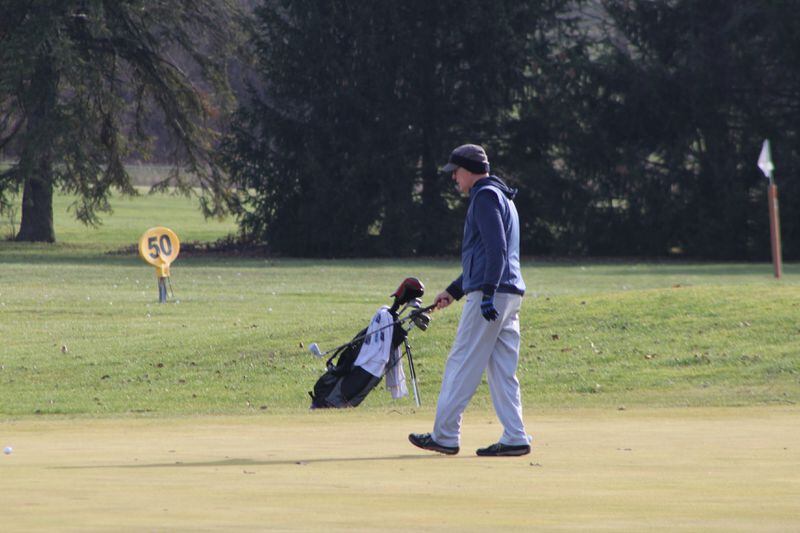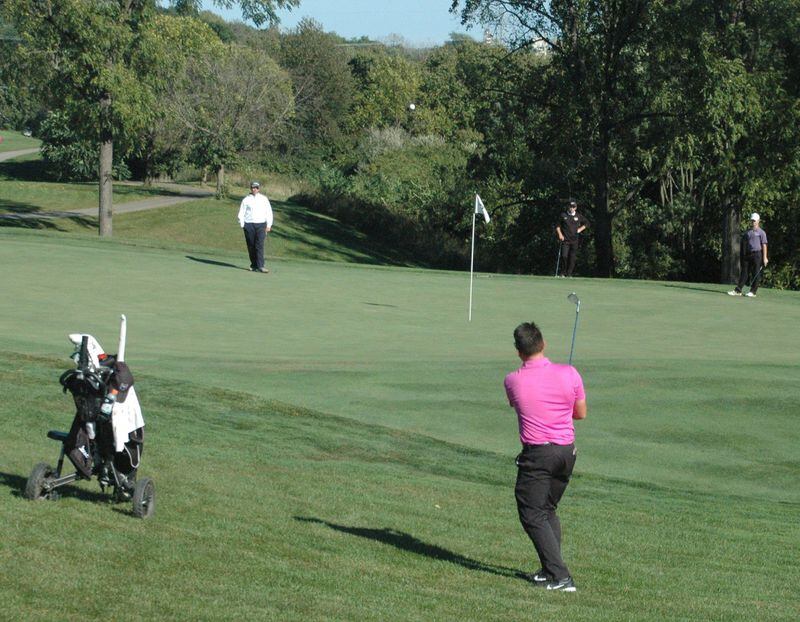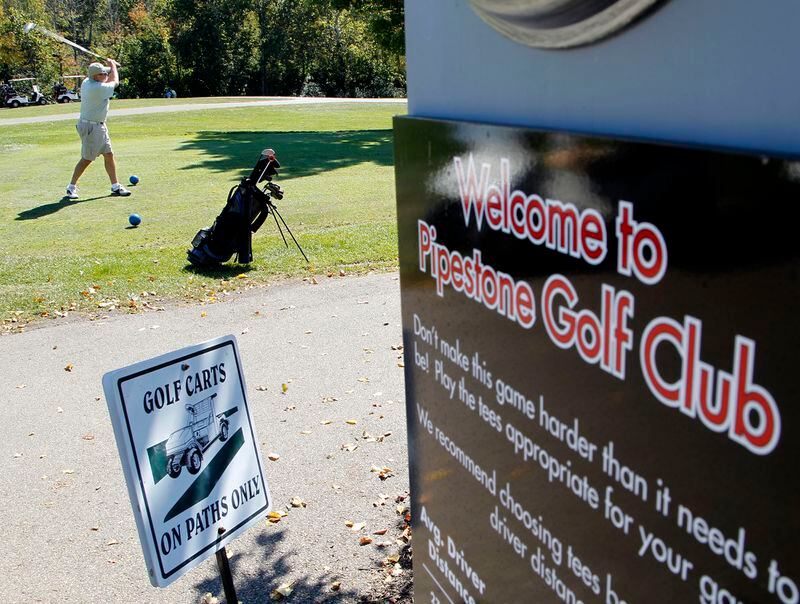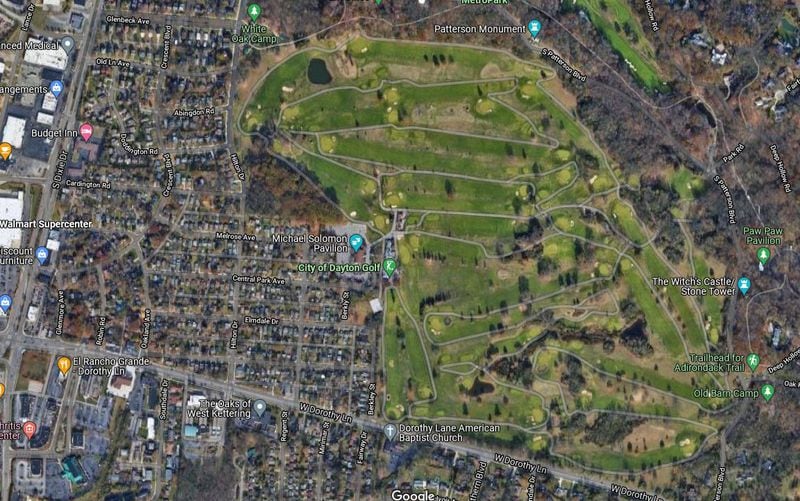
A man practices putting at Community Golf Club, which is the city of Dayton’s only remaining golf course, after it closed Kittyhawk Golf Center and Madden Golf Course. CORNELIUS FROLIK / STAFF

A man practices putting at Community Golf Club, which is the city of Dayton’s only remaining golf course, after it closed Kittyhawk Golf Center and Madden Golf Course. CORNELIUS FROLIK / STAFF
After years of struggles to grow the game of golf, interest in the sport during COVID soared like a ball whacked by a PGA Tour pro.
There have been 31,750 rounds of golf played this year at Beavercreek Golf Club — which is up 8% from 2020.
That is the most rounds played at the facility since 2005, and it follows an even more impressive year of growth. Rounds played increased 16% in 2020.
Lakota East’s Joe Wilson chips onto the 18th green last week during the Division I district boys golf tournament at Beavercreek Golf Club. RICK CASSANO/STAFF

Lakota East’s Joe Wilson chips onto the 18th green last week during the Division I district boys golf tournament at Beavercreek Golf Club. RICK CASSANO/STAFF
“Our course has seen a drastic increase in interest this year,” said Steve Klick, Beavercreek Golf Club’s director of operations.
The pandemic forced people to find new ways to enjoy each other’s company in a safe manner that allows for social distancing, Klick said.
Golf is a great way to enjoy the outdoors while engaging in friendly competition, Klick said, adding that he thinks interest in the game will to continue to increase as more people try it out and get hooked.
Miamisburg’s Mound Golf Course and PipeStone Golf Club saw an 11% and 12% increase in rounds played this year, respectively, which comes after even more robust growth in 2020.
PipeStone has 18 holes, while Mound has 9.
Miamisburg City Council has approved an ordinance to sell about 0.044 acres of Pipestone Golf Club land for $500, records show. FILE PHOTO

Miamisburg City Council has approved an ordinance to sell about 0.044 acres of Pipestone Golf Club land for $500, records show. FILE PHOTO
Early in the pandemic, golf was one of the few recreational options available, and the sport provides both physical and mental health benefits, said Ryan Davis, Miamisburg’s parks and recreation director.
Many people tried golf for the first time in the last two years and many established golfers went from playing a couple times a month to hitting the courses far more regularly, he said.
Davis said it’s unclear how COVID will impact people’s leisure time activities and priorities in the long-run, but golf participation always has been cyclical, with “ups and downs.”
“The city of Miamisburg believes it is likely we will see some continued growth in 2022 and then may decline toward whatever the next ‘normal’ level of play will be,” he said.
He added, “Our current estimates over the next three to five years are that the trend will likely be somewhere between the 2020 and 2021 figures, likely leveling off, but not returning to pre-pandemic levels in the short term.”
An aerial view of Community Golf Club. CONTRIBUTED

An aerial view of Community Golf Club. CONTRIBUTED
The city of Dayton last year permanently closed two of its golf facilities for financial reasons: Kittyhawk Golf Center and Madden Golf Course.
After that and during COVID, the city’s last remaining facility, Community Golf Club, saw a large increase in demand.
Through Dec. 20, there have been 82,417 rounds of golf played at Community’s two courses, which is up more than 4% compared to all rounds of golf played at city facilities in 2020.
Last year was the first year since the Great Recession that the city’s golf budget ended with a surplus, which will allow the division to make investments in its facilities, said Kelly Pressel, Dayton’s manager of the golf division.
The city is mostly finished with bunker renovations at Community Golf Club that seek to correct drainage issues that basically turned the bunkers into mini-lakes, Pressel said.
The city also has paid for a master plan for Community that studies and makes recommendations for improvement to the 36-hole facility.
The city hopes to increase customer satisfaction, reduce maintenance costs and support player development and other goals.
Golf grew in popularity from the late 1980s until the early 2000s, but the sport experienced contraction after that and a significant number of courses closed, said Jurick, with the Miami Valley Golf Association.
But Jurick said demand for the sport now exceeds the supply, and it is attracting new players.
He also said new courses are opening in the region, including Gray Wolf Golf Club in Clayton and Jasper Hills Golf Club. Gray Wolf is on the site of the former Moss Creek course, and Jasper Hills is on the site of the former Sebastian Hills Golf Club southeast of Xenia, which closed in 2017.
COVID led to social isolation and disconnection, but the pandemic “reset” the public’s mindset about golf, and many people have come to appreciate the activity and value it once more, Jurick said.
“It’s one of the only sports, other than tennis, that you can play your whole life,” he said. “It’s a wonderful sport from a health and wellness standpoint.”
Also, he said, the region’s golf offerings are very affordable compared to much of the rest of the nation, which means there isn’t as high a barrier to entry.
This news is republished from another source. You can check the original article here


